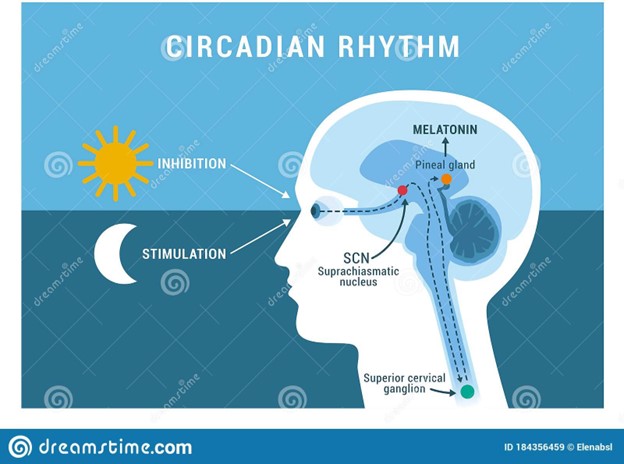A night-shift worker experiences extreme difficulty falling asleep due to being exposed to bright lights during both night and day.
The unusual pattern of light exposure is disturbing which controls the release of the hormone:
Metabolic rate; thyroxine.
Limbic system; thymosin.
Circulatory system; dopamine.
Circadian rhythm; melatonin.
The Correct Answer is D

Circadian rhythm is the term for the biological clock that regulates the sleep-wake cycle and other physiological processes in the body.
Melatonin is a hormone that is produced by the pineal gland in the brain in response to darkness.
It helps with the timing of the circadian rhythm and promotes sleep.
Choice A is wrong because metabolic rate is not affected by light exposure, and thyroxine is a hormone that regulates metabolism, not sleep.
Choice B is wrong because the limbic system is a part of the brain that is involved in emotions, memory, and motivation, not sleep.
Thymosin is a hormone that stimulates the development of T cells, which are part of the immune system.
Choice C is wrong because the circulatory system is the system of blood vessels and organs that transport blood throughout the body, not a part of the brain that controls sleep.
Dopamine is a neurotransmitter that is involved in reward, motivation, and movement, not sleep.
Nursing Test Bank
Naxlex Comprehensive Predictor Exams
Related Questions
Correct Answer is C
Explanation
Basophils usually account for the smallest percentage of leukocytes in a blood sample. Basophils are a type of white blood cell that is involved in allergic reactions and inflammation.
Choice A is wrong because eosinophils are not the least common type of leukocyte.
Eosinophils are another type of white blood cell that is involved in allergic responses and parasitic infections.
They typically make up about 1-6% of the total leukocyte count.
Choice B is wrong because monocytes are not the least common type of leukocyte.
Monocytes are a type of white blood cell that can differentiate into macrophages and dendritic cells, which are important for phagocytosis and antigen presentation.
They typically make up about 2-10% of the total leukocyte count.
Choice D is wrong because neutrophils are not the least common type of leukocyte.
Neutrophils are a type of white blood cell that are the first responders to bacterial infections and tissue damage.
They typically make up about 55-70% of the total leukocyte count.
Correct Answer is B
Explanation
Monocytes are a type of agranulocytes, which are white blood cells that lack visible granules in their cytoplasm.
Agranulocytes also include lymphocytes, which are involved in adaptive immunity.
Choice A is wrong because basophils are a type of granulocytes, which are white blood cells that have granules in their cytoplasm.
Granulocytes also include neutrophils and eosinophils, which are involved in innate immunity.
Choice C is wrong because neutrophils are also a type of granulocyte.
Neutrophils are the most abundant white blood cells and are responsible for phagocytizing bacteria and fungi.
Choice D is wrong because eosinophils are also a type of granulocytes. Eosinophils are involved in allergic reactions and parasitic infections.
Normal ranges for white blood cells vary depending on age, gender, and health status, but generally, they are between 4,000 and 11,000 cells per microliter of blood.
Whether you are a student looking to ace your exams or a practicing nurse seeking to enhance your expertise , our nursing education contents will empower you with the confidence and competence to make a difference in the lives of patients and become a respected leader in the healthcare field.
Visit Naxlex, invest in your future and unlock endless possibilities with our unparalleled nursing education contents today
Report Wrong Answer on the Current Question
Do you disagree with the answer? If yes, what is your expected answer? Explain.
Kindly be descriptive with the issue you are facing.
